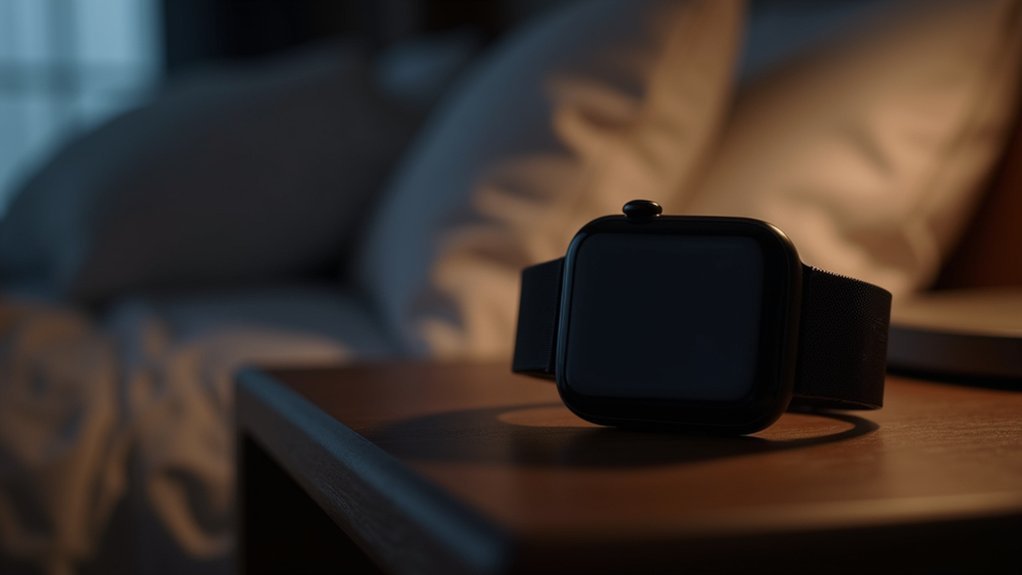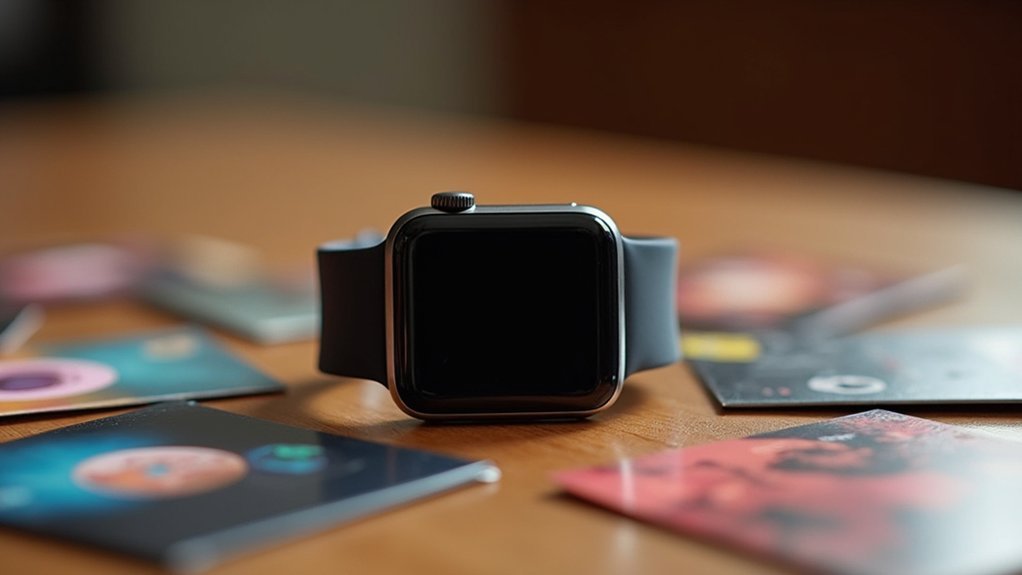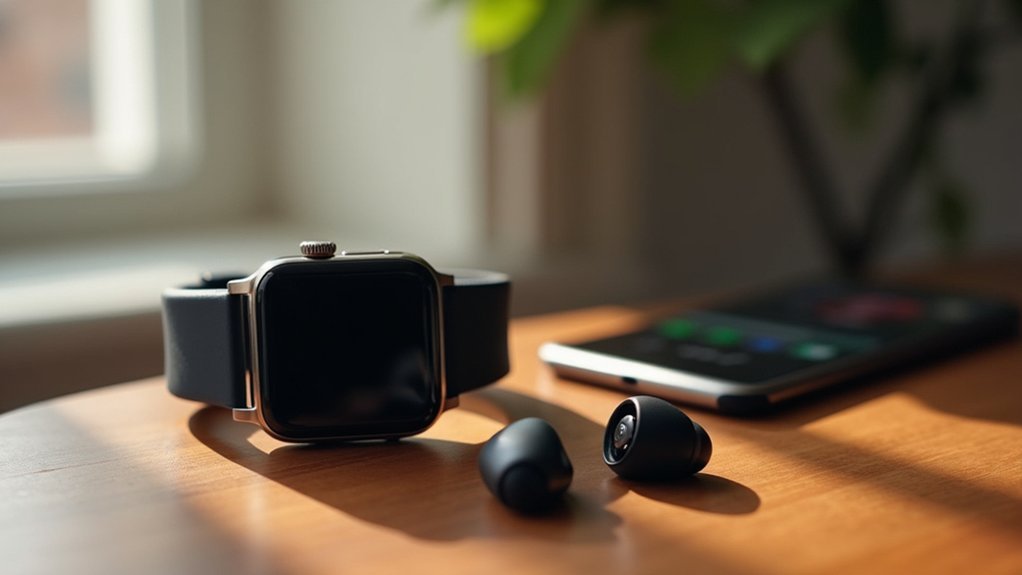Your smartwatch decodes deep sleep by analyzing heart rate variability and micro-movements through advanced sensors and machine learning algorithms. It achieves over 95% accuracy in distinguishing sleep from wake states, though it tends to overestimate light sleep while underestimating deep and REM phases. Multi-sensor fusion combines accelerometer data with pulse oximetry to segment your sleep into detailed intervals, helping assess recovery and sleep quality. Discover how different brands’ algorithms impact your sleep insights.
The Science Behind Smartwatch Sleep Detection Technology

While you sleep, your smartwatch works tirelessly to decode the complex patterns of your slumber using an array of sophisticated sensors and algorithms. Your device primarily relies on heart rate variability and accelerometer data to estimate sleep stages, though it can’t directly measure brain activity like clinical polysomnography does.
Advanced models incorporate pulse oximetry sensors that track oxygen saturation, helping detect breathing irregularities during deep sleep phases. Some devices even monitor skin temperature and electrodermal activity for additional insights.
Modern smartwatches deploy pulse oximetry and temperature sensors to detect subtle breathing patterns and physiological changes throughout your sleep cycle.
Machine learning algorithms trained on vast polysomnography datasets analyze your sensor data through epoch-by-epoch classification, segmenting your night into short intervals. These algorithms track your sleep cycles which typically repeat every 90 to 110 minutes throughout the night.
Multi-sensor fusion combines heart rate, movement, oxygen levels, and temperature readings to improve accuracy, while proprietary algorithms incorporate circadian rhythm predictions to refine sleep stage identification.
Heart Rate Variability and Movement Sensors in Sleep Analysis
Your smartwatch doesn’t just track your heart rate—it measures heart rate variability (HRV) during your deepest sleep phases to capture your body’s true recovery state.
While you’re sleeping, movement sensors detect micro-movements and stillness periods that reveal shifts between light and deep sleep stages.
These two data streams work together through sophisticated algorithms that fuse HRV patterns with movement recognition to paint a complete picture of your sleep quality. HRV reflects the competing signals from your parasympathetic and sympathetic nervous systems, with the balance between these branches determining how well your body recovers overnight.
HRV During Sleep Stages
As your heart beats throughout the night, the subtle variations in timing between each beat tell a complex story about your autonomic nervous system’s activity during different sleep stages.
Your smartwatch captures these HRV patterns to distinguish between wake, light sleep, deep sleep, and REM phases.
Here’s what happens during each stage:
- Deep Sleep (Slow Wave) – Your parasympathetic nervous system dominates around 2:00 AM, creating maximal HRV stability and the most reproducible measurements.
- REM Sleep – Sympathetic surges become more frequent and intense, especially in early morning, reducing HRV stability considerably.
- Light Sleep – You’ll experience moderate parasympathetic activity with better HRV reproducibility than REM but less than deep sleep.
Your smartwatch combines these HRV signatures with movement data to accurately classify your sleep stages. For individuals recovering from heart attacks, these measurements become particularly crucial since they show sympathetic dominance during sleep instead of the normal vagal activation that healthy individuals experience.
Movement Pattern Recognition
Beyond tracking your heartbeat patterns, your smartwatch’s accelerometer and gyroscope work tirelessly to detect every subtle wrist movement throughout the night. This actigraphy-based approach differentiates between sleep and wake states by monitoring your activity levels during rest periods.
Your movement patterns reveal vital insights into sleep fragmentation, restless leg syndrome, and arousals that impact your sleep quality. Periods of stillness correlate with deeper sleep phases, while restlessness indicates lighter stages or potential disruptions.
| Movement Pattern | Sleep Stage | Interpretation |
|---|---|---|
| Minimal movement | Deep sleep | Quality restorative rest |
| Slight restlessness | Light sleep | Shift phase |
| Frequent motion | REM sleep | Active dreaming state |
| Sudden movements | Arousals | Sleep disruptions |
| Continuous activity | Wake | Conscious movement |
However, movement data alone has limitations in distinguishing fine sleep stages, requiring combination with heart rate variability for improved accuracy. Understanding these sleep patterns helps identify external factors that may be hindering your ability to achieve the deep, restorative sleep your body needs for proper reset and energy replenishment.
Sensor Data Fusion
When smartwatches combine heart rate variability data with movement sensors, they create a thorough picture of your sleep architecture that neither metric could provide alone. This multi-sensor approach enhances accuracy by cross-validating sleep stages through different data streams.
Your smartwatch uses sophisticated fusion techniques to overcome individual sensor limitations:
- Kalman filters smooth out movement-induced noise that can distort heart rate readings during restless sleep periods.
- Machine learning models integrate HRV patterns with accelerometer data to distinguish between light sleep movements and actual wake periods.
- Bayesian networks combine respiratory rate detection from movement sensors with cardiac data to identify potential sleep disorders like apnea.
This integrated approach provides personalized sleep insights that go beyond simple sleep tracking, offering actionable advice for improving your sleep quality and overall health monitoring. The multi-sensor fusion helps reduce false alarms that could otherwise interrupt your sleep analysis with inaccurate readings.
Comparing Smartwatch Accuracy Against Medical Sleep Studies
While your smartwatch confidently displays detailed sleep stage breakdowns each morning, how does this data actually compare to what sleep scientists consider the gold standard?
Polysomnography (PSG) remains the clinical benchmark, and when researchers pit consumer devices against it, interesting patterns emerge.
Your smartwatch excels at distinguishing sleep from wake states—achieving 95% accuracy or higher. However, it’s telling a different story about your sleep stages. Devices consistently overestimate light sleep while underestimating deep and REM phases.
You’re likely getting about 17 minutes less total sleep time than PSG would measure, and your sleep efficiency appears 4.7% lower. Consumer trackers may also struggle with accurately detecting wake periods during the night.
The Oura Ring shows slightly better stage detection than wrist-based devices, but all consumer trackers struggle with deep sleep accuracy.
Brand Performance Rankings for Deep Sleep Detection
Most smartwatch brands cluster around 70-80% accuracy for sleep stage detection, but notable differences emerge when you examine their specific approaches to tracking deep sleep.
Top Performers by Category:
- Best Overall Accuracy: Fitbit devices (Sense 2/3, Charge 6) lead with multi-sensor arrays combining PPG, SpO₂, and skin temperature data, delivering the most reliable deep sleep measurements among consumer wearables.
- Best Battery Life: Garmin Venu 3 and Fenix 8 offer multi-day battery performance, ensuring uninterrupted sleep tracking without daily charging concerns that can affect data completeness.
- Best Comfort: Oura Ring 4 and Samsung Galaxy Ring excel in overnight wearability, reducing motion artifacts and promoting consistent use—critical factors for accurate deep sleep pattern analysis. The Oura Ring 4’s sleep staging algorithm has demonstrated accuracy levels matching professional polysomnography sleep lab tests.
Apple Watch Series 10 tracks sleep onset well but struggles with stage detection reliability compared to competitors.
Algorithm Differences Between Fitbit, Apple Watch, and Garmin Devices
Behind the scenes, each major smartwatch brand employs fundamentally different approaches to analyze your sleep data, which explains why you’ll see dramatically different deep sleep readings when switching between devices.
Fitbit’s algorithm combines heart rate variability with movement data and skin temperature, creating a proprietary model that mimics clinical polysomnography. This approach typically reports longer deep sleep durations, often exceeding one hour.
Apple Watch relies primarily on heart rate and motion sensors but excludes skin temperature from its native algorithm. It takes a more conservative approach to deep sleep classification, frequently reporting less than one hour of deep sleep while showing higher estimates for light and REM stages. The device measures sleep duration, heart rate, and movement disturbances to provide comprehensive sleep insights.
Garmin enhances its tracking by incorporating respiration rate and oxygen saturation data, focusing on an overall sleep quality score rather than precise stage accuracy.
Understanding Sleep Stage Classification Limitations

Even though smartwatch algorithms have grown increasingly sophisticated, the fundamental challenge lies in translating complex sleep physiology into discrete categories that your device can recognize and display. Your sleep doesn’t actually occur in neat, separate stages—it’s a continuous, overlapping process that defies rigid classification.
Three key limitations affect your smartwatch’s accuracy:
- Mixed States: Your device analyzes 30-second windows and assigns one dominant stage, missing interim periods where multiple sleep states occur simultaneously.
- Indirect Signals: Without direct brain monitoring, your watch relies on heart rate and movement patterns that provide less detailed information than medical-grade EEG equipment.
- Class Imbalance: Algorithms favor longer stages like N2 sleep while struggling with shorter phases like N1 and N3.
Sleep research relies on three major vigilance states that form the foundation of how scientists understand and categorize our nightly rest cycles.
Practical Applications for Athletes and Sleep Health Monitoring
Despite the classification limitations discussed earlier, your smartwatch becomes a valuable tool when you shift focus from precise sleep stage accuracy to practical recovery insights.
You’ll find that tracking sleep timing, duration, and consistency provides more reliable indicators than exact stage classifications.
Your device’s heart rate variability and temperature monitoring can signal early illness or excessive stress before symptoms appear. This enables proactive adjustments to your training intensity and rest periods.
Your smartwatch detects illness and stress signals before symptoms emerge, allowing you to adjust training and recovery proactively.
When you integrate this multi-parameter data, you’re empowered to make smarter decisions about recovery enhancement. However, it’s important to have a clear plan for how you’ll use this data to justify the investment and avoid purchasing based on trends alone.
Long-term sleep trends help you identify patterns affecting performance, while objective measurements supplement your sleep diary entries.
You can correlate deep sleep quantity with athletic output, schedule training around ideal recovery periods, and maintain peak readiness throughout competitive seasons.
Future Innovations in Wearable Sleep Tracking Technology

You’ll soon experience dramatically improved sleep insights as advanced sensor integration combines multispectral sensing with ECG and respiratory tracking for unprecedented accuracy.
Machine learning algorithms will continuously adapt to your unique sleep patterns, delivering personalized recommendations through AI-powered virtual coaching that evolves with your data. Generative AI transforms wearables from simple data trackers into comprehensive wellness coaches that provide holistic health guidance.
You can expect hybrid device development to expand beyond smartwatches into smart rings and glasses, offering discreet monitoring options that seamlessly integrate with bedside technology for thorough sleep analysis.
Advanced Sensor Integration
While traditional smartwatches relied on basic accelerometers and optical heart rate sensors, today’s advanced devices integrate multiple sophisticated sensors that work together to create a thorough picture of your sleep patterns.
Your smartwatch now combines several key technologies:
- Multi-modal detection systems – Accelerometers capture micro-movements like wrist twitches, while skin temperature sensors monitor circadian rhythm changes and SpO2 sensors detect oxygen desaturation events linked to sleep apnea.
- FDA-approved medical-grade components – High-sensitivity accelerometers and ECG sensors provide near-clinical validation levels for detecting obstructive sleep apnea episodes and heart arrhythmias during sleep.
- Environmental contextual monitoring – Future devices will measure ambient light, noise levels, and respiration rates to correlate environmental disruptions with your sleep quality.
This sensor fusion creates personalized sleep coaching by understanding how your surroundings impact rest. Advanced sleep tracking includes detailed sleep stages analysis that helps users understand the quality and depth of their rest cycles throughout the night.
Machine Learning Algorithms
As your smartwatch processes the vast amounts of sensor data it collects throughout the night, sophisticated machine learning algorithms transform raw measurements into actionable sleep insights. Deep learning models now achieve remarkable predictive accuracy, with CNNs reaching an AUC of 0.9449 compared to traditional linear regression’s 0.6463. These algorithms don’t just analyze your sleep after it happens—they proactively forecast sleep efficiency using your daytime wearable data.
| Algorithm Type | AUC Performance | Key Benefit |
|---|---|---|
| Deep Learning (CNN) | 0.9449 | Real-time sleep quality prediction |
| Linear Regression | 0.6463 | Basic pattern recognition |
| AI-Enhanced Systems | 0.90+ | Proactive sleep disorder prevention |
Your smartwatch’s AI integration enables real-time monitoring and clinical-grade sleep disorder detection, including sleep apnea identification through enhanced sensitivity and specificity measurements. Advanced models can predict poor sleep efficiency with 4–8 hours notice before you even get into bed, allowing for proactive behavioral interventions.
Hybrid Device Development
Hybrid smartwatches represent the next frontier in sleep tracking technology, seamlessly merging traditional analog craftsmanship with cutting-edge digital health monitoring capabilities.
You’ll experience unprecedented battery efficiency with these devices, offering up to 30 days of analog functionality while maintaining continuous sleep monitoring. The multi-layer technology combines mechanical hands with vibrant TFT displays, ensuring you don’t sacrifice style for functionality.
These devices incorporate medical-grade ECG capabilities that can detect cardiac anomalies even during sleep cycles, providing crucial health insights throughout the night.
Key advantages of hybrid sleep tracking include:
- Extended monitoring periods – Low-energy analog components keep your watch running even when digital features are dormant.
- Comprehensive sleep analysis – Advanced sensors capture heart rate variability, sleep stages, and movement patterns simultaneously.
- Seamless data integration – Companion apps synchronize sleep metrics with other health indicators for holistic wellness insights.
You’ll receive detailed sleep reports without frequent charging interruptions, making long-term pattern analysis more reliable.
Frequently Asked Questions
Can Smartwatches Detect Sleep Apnea or Other Serious Sleep Disorders?
You can’t officially diagnose sleep apnea with smartwatches, but they’ll detect warning signs with 75-96% sensitivity. You’ll still need a professional sleep study for definitive diagnosis, though they’re excellent screening tools.
Should I Wear My Smartwatch Every Night or Give My Skin Breaks?
You should give your skin regular breaks from wearing your smartwatch every night. Remove it daily for cleaning and charging, and take occasional nights off to prevent irritation and bacteria buildup.
Do Smartwatches Work Accurately for People With Irregular Work Schedules?
Smartwatches struggle with irregular schedules since they’re designed for fixed sleep windows. You’ll need to manually adjust settings daily, and automatic modes often miss sleep data when your hours don’t align.
How Much Battery Life Do Smartwatches Lose When Tracking Sleep Overnight?
You’ll typically lose 10-20% battery overnight when sleep tracking, though some users report up to 50% drain. Heart rate monitoring, Always On Display, and multiple sensors contribute to higher consumption during sleep.
Can Medications or Health Conditions Affect Smartwatch Sleep Tracking Accuracy?
Yes, medications like sleep aids, antidepressants, and benzodiazepines can alter your sleep patterns, affecting tracking accuracy. Health conditions including Parkinson’s disease, sleep disorders, and neurological conditions also impact how smartwatches detect sleep stages.
In Summary
You’re getting valuable insights from your smartwatch’s sleep tracking, but you shouldn’t rely on it as your only source of sleep data. While these devices excel at detecting sleep duration and basic patterns, they’re still catching up to medical-grade accuracy for deep sleep stages. You’ll see the most benefit when you combine your smartwatch data with good sleep hygiene practices and consult healthcare professionals for serious sleep concerns.





Leave a Reply